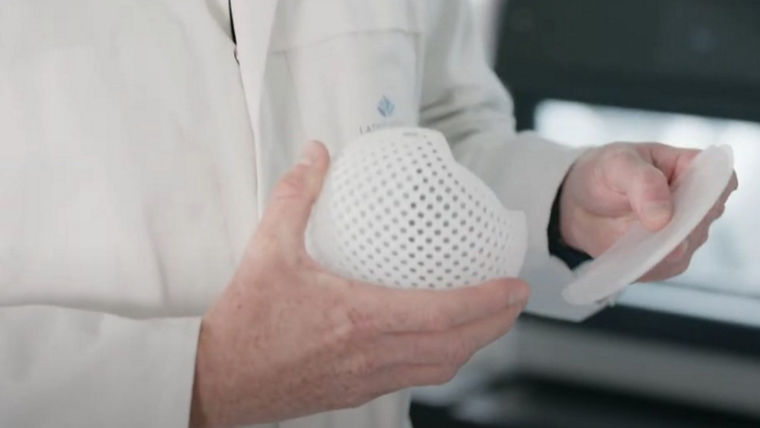Breast cancer is one of the most common cancers among women—one in eight women in industrialized countries will be affected during their lifetime. For many patients, treatment involves a mastectomy, the surgical removal of the breast. Most women who choose to reconstruct their breast afterward opt for silicone implants. However, in the future, the bioresorbable polymer (polycaprolactone) marketed by Evonik under the brand name Resomer could enable a new form of breast reconstruction—one that is highly individualized and particularly biocompatible.
ELEMENTS-Newsletter
Get exciting insights into Evonik's research and its societal relevance—delivered conveniently via email.
Evonik already has customers in this field. The French medical technology company Lattice Medical and the German company BellaSeno use 3D printing to manufacture patient-specific implants that support the body’s natural cell growth.
The Mattisse implant developed by Lattice Medical is a 3D-printed, bioresorbable tissue engineering chamber. It is filled with body fat previously harvested from other areas of the patient’s body. The chamber protects and shapes the breast while gradually dissolving over 18 months.
BellaSeno uses a 3D scaffold coated with the patient’s own body fat. Its open-pore, lattice-like structure promotes tissue formation while providing stability. Over time, the scaffold is broken down by the body and replaced with natural tissue.

Healing with the help of living cells
Both methods leverage the fact that the harvested fat tissue contains living cells, including stem cells capable of regenerating tissue. These cells help form new blood vessels that grow into the tissue over time. This allows the tissue to survive and develop into a living, structural new form.

At the same time, structures made from bioresorbable material can avoid common issues associated with silicone implants, such as the risks of capsular fibrosis, implant failure, foreign body reactions, and repeated surgeries with long recovery times.
Degradation in the body
Evonik has developed a variant of Resomer specifically tailored to these medical 3D printing applications. This includes adjustments to crystallinity, processing temperature, and a melting point optimized for 3D printing at up to 200 degrees Celsius. Resomer can be formulated to degrade at approximately the same rate as the body’s natural tissue formation. It completely dissolves within 12 to 48 months. Its mechanical properties ensure that the scaffold is stable enough to maintain its shape while being flexible enough to adapt to the body.

Initial clinical results are encouraging. One year after receiving BellaSeno’s novel implant structures, patients showed an 87% breast volume retention, low complication rates, and natural softness. Quality of life was high, with improvements in both physical and psychological well-being. After two years, a vascular network had formed in the newly developed breast tissue. Lattice Medical is also currently conducting clinical trials in France and Spain to evaluate the efficacy and safety of its method.
Materials Science as the Key to Personalization
The Resomer polymer is already used in many other medical procedures, such as interference screws in orthopedics or stents and catheters for cardiovascular applications. Patients benefit from the fact that the material completely degrades in their bodies within a timeframe of less than a month to four years, eliminating the need for additional surgical interventions.



